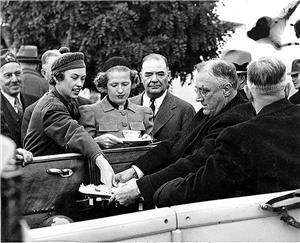On August 3, 1934, President Franklin D. Roosevelt (1882-1945) visits Grand Coulee Dam, a massive public works project undertaken as part of Roosevelt’s efforts to ease joblessness during the Depression.
Advocates of the dam, located on the Columbia River in Central Washington, had lobbied for federal support for the project for years. Only the federal government had the resources to build the kind of dam that had been envisioned: a structure 550 feet tall and nearly a mile wide, holding back a reservoir that would reach 150 miles to the Canadian border. The dam would be equipped with two huge hydroelectric powerplants, but its main function would be to pump water onto 1.1 million acres of desert. The price tag was an estimated $400 million.
Roosevelt’s predecessor, Herbert Hoover (1874-1964) -- an engineer -- rejected the plans for Grand Coulee Dam and the related Columbia Basin Irrigation Project. He said it was too expensive, that there would be no market for the power produced by the dam, and that there was no need to bring new farmland into production because the nation’s farmers were already producing an agricultural surplus.
Roosevelt, too, objected to the price and the scope of the project, and initially rejected it altogether. Shortly after taking office, in January 1933, he committed funds for the construction of Bonneville Dam, located on the lower Columbia in southwestern Washington. He was concerned about spending federal dollars on two large public works projects in a region with a relatively small population. Washington Senator Clarence Dill (1884-1978), a Democrat from Spokane, was among those who finally convinced Roosevelt to change his mind.
However, Roosevelt asked that the project be scaled down. He argued that a smaller, lower dam would put the unemployed to work; would generate low-cost electricity; and could be enlarged later if needed. In July 1933, his Public Works Board appropriated $63 million for a 290-foot dam with no irrigation facilities. His decision put the Columbia Basin Project on hold, since a low dam would not support the kind of irrigation system that had been envisioned. Still, the project was assigned to the Bureau of Reclamation rather than to the Army Corps of Engineers, which increased the likelihood that it would be completed as designed at some point.
Initial excavation began in August 1933. The contract to build the dam was awarded in June 1934 to a consortium of three companies – Silas Mason Company of New York, Atkinson-Kier Company of San Francisco, and Walsh Construction Company of Davenport, Iowa -- known by the acronym MWAK. Roosevelt visited the construction site for the first time not long after the work began.
Roosevelt and his companions -- including Washington Governor Clarence D. Martin (1884-1955) and Secretary of the Interior Harold Ickes -- stopped first at Bonneville Dam, on August 3, 1934. From there, they traveled by train through Spokane and on to Ephrata, continuing in cars to Grand Coulee.
More than 20,000 people awaited the president, who arrived at the dam site at 11:05 a.m. and gave a brief speech. “It was perfectly astounding to see so many people in a desert country,” Ickes noted in his diary. “Some of them must have driven two or three hundred miles to see and hear the president.” The president’s wife, Eleanor Roosevelt, looked around and reportedly said “It was a good salesman who sold this to Franklin” (quoted in Pitzer, 101).
Supporters of the high dam continued to lobby Roosevelt during his visit to the dam site. Banners and signs were placed along the president’s route, pleading for support for the high dam and the irrigation project. What effect this had, if any, is not known, but within two years, the original contract had been modified and the Grand Coulee High Dam was under construction.
Roosevelt returned to Grand Coulee on October 2, 1937. By that time, the dam was being described as “the Eighth Wonder of the World” -- a structure as tall as a 46-story building, just five feet shorter than the Washington Monument, destined to contain more than 12 million cubic yards of concrete. Roosevelt marveled at the progress that had been made in three years. “The easiest way to describe those figures is to say that this is the largest structure, so far as anybody knows, that has ever been undertaken by man in one place,” he said. “Superlatives do not count for anything because it is so much bigger than anything ever tried before ...” (Roosevelt, 395).
Roosevelt became a champion of Grand Coulee as a reclamation project. He believed water pumped from the dam’s reservoir could be used to open up lands that could be worked by “thousands” of farmers relocated from other parts of the country. That vision was never fully realized, but Grand Coulee did become the nation’s powerhouse, producing more electricity than any other dam in the United States. As of 2005, it was eclipsed by only two other dams in the world.

